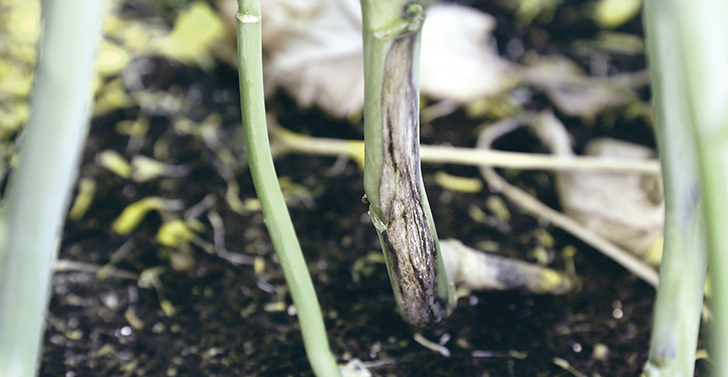By knowing the type of blackleg and matching it with the resistant labels in seed, growers can better manage the pathogen
A rapid blackleg test from Agriculture Canada is now available.
“We have developed a set of molecular markers that can tell us exactly what races are in the field,” research scientist Hossein Borhan said at CanolaPalooza in Sask-atoon.
“The markers have been tested over several years in the lab. They are very robust, and we have recently released these markers to several of the provincial and also private labs, to conduct diagnostic tests.”
The markers have been developed through a research project with support from Sask Canola, the Agriculture Development Fund and Agriculture Canada.
Read Also

Growing garlic by the thousands in Manitoba
Grower holds a planting party day every fall as a crowd gathers to help put 28,000 plants, and sometimes more, into theground
A commercial blackleg race test may be available for producers as soon as next year once the molecular markers and a protocol are tested and validated through the diagnostic labs.
Labs used to tell farmers only if their sample had blackleg or root rot in it.
Justine Cornelsen, an agronomy specialist with the Canola Council of Canada, said the new testing protocol will greatly help growers manage blackleg.
“It will pair up really well with the new R gene labels, so producers will then know what genetics they are using in their varieties, major gene genetics, and then they will be able to match it up with the actual pathogen in their field or fungus in their field.” Cornelsen said.
The Western Canada Canola/Rapeseed Recommending Committee approved a new labelling system last winter for major gene canola resistances as a way to extend the life of the resistant genes. The system identifies specific resistant genes in the varieties and place them into one of 10 groups.
The existing labelling system for canola, including the R and MR annotations, has been retained to help distinguish the qualitative resistance in the canola cultivars.
The labelling system is voluntary and it may take years for all seed companies to buy in, but the availability of the new blackleg race testing for producers may hasten seed company participation.
“I think that was a concern from some companies, they were wanting this step (blackleg race testing) to come as well,” Cornelsen said.
Dekalb is the only company that includes the blackleg resistant genes on its canola variety labels.
“They (Dekalb) have released their 2018 seed guide and have incorporated their R gene labels in there,” Cornelsen said.
“So they’ve done a really good job to outline the groups because we’ve grouped these genes, and then they have put the associated gene next to it.”
She said other companies plan to have their labels out within a year.
Seed companies still have reservations about the blackleg resistant labelling system because an over-emphasis on major gene blackleg resistances may not be a good long-term strategy in terms of durability of the resistance.
“A lot of those (blackleg resistant canola) varieties have a pair of major and minor genes, and that’s probably what’s been doing lots of the heavy lifting in Canada, are those minor genes.”
Gary Peng, a research scientist with Agriculture Canada, has shown through his work that the major gene (qualitative resistance) commonly used in commercially available canola varieties are now largely ineffective, and it is minor gene (quantitative resistance, which is race non-specific) in cultivars developed by canola breeders that is currently suppressing blackleg.
“Qualitative resistance is kind of a backbone of the current varieties for now,” Peng said during a presentation at Murray Hartman’s Science-O-Rama in Lacombe, Alta., last spring.
“It is a valuable resource to us. The drawback of only relying on qualitative resistance is when we have things like hail damage, that’s where that resistance will start falling down.”
Damage to canola plants from root maggots and flea beetles can also allow blackleg to bypass qualitative resistance and infect the stem.
Major gene resistance allows even wounded plants to resist a blackleg infection and the associated yield loss that it causes.
The problem with major gene resistance is that it can quickly break down if it is relied on too heavily.
It is hoped the labelling system in combination with new testing procedures will help protect new major gene resistances in the developmental pipeline. This is because growers with blackleg problems can now better understand which major gene resistance is breaking down in their field, and they can rotate to a different resistance package.
Growers previously had to switch to a different R rated variety, which may have used the same resistant genes.
The blackleg pathogen is present in the majority of prairie fields, including more than 90 percent in Alberta, but there is still low incident rate of blackleg infections in Canadian canola.
There are also concerns that the disease can be used against the Canadian canola industry to deny market access, especially by China, which has stated it does not want to risk importing blackleg in shipments of Canadian canola.
When it comes to controlling blackleg, Cornelsen said the best defence is focusing on the extension of rotations, scouting for the disease and knowing what you’re looking for.
“Right now is a good time,” Peng said. “If you are seeing root rot symptoms or potentially blackleg, if you’re not sure about what you’re seeing, make sure to send those samples away because they will help to at least identify what you’re dealing with.”


















